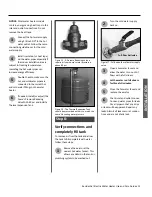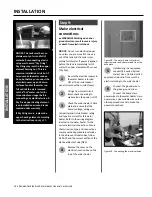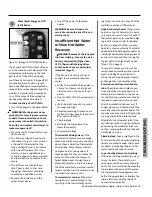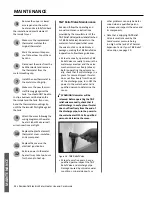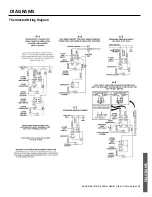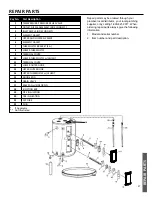
22 • Residen al Electric Water Heater Use and Care Guide
anode rod more frequently, replacing
the anode rod as needed. Obtain new
anode rods from your local plumbing
supplier or have a quali
fi
ed person
replace it. (Anode rods are a consum-
able item and are not covered under
warranty).
8
If the sediment was present
when the tank was drained,
fl
ush the tank by opening the
cold water supply valve and le ng the
water run un l no more sediment
drains from the tank. Close the drain
valve when you are done.
NOTICE:
Do not turn power back on
un l the tank is completely full of wa-
ter. For complete instruc ons on
fi
lling
the tank, follow Step 8 in the Installa-
on sec on.
9
Re
fi
ll the tank by opening the
cold water supply valve. Make
sure a hot water faucet is
open and the drain valve is closed.
Allow the hot water to run full for at
least three minutes to make sure the
tank has all the air removed and is
completely full of water. Failure to
perform this step can cause the upper
hea ng element to burn out. Once you
are certain the tank is completely full
of water, close the hot water faucet.
10
Restore power to the water
heater. It may take two hours
for the tank to heat up.
Replacing the Hea ng Element
WARNING! Working on an ener-
gized circuit can result in severe injury
or death from electrical shock. Turn
power o
ff
. Check wires with a non-
contact circuit tester to make sure
power is o
ff
. When you are
fi
nished,
be sure all covers are secured to re-
duce the risk of
fi
re and electric shock.
If you are not comfortable replacing a
hea ng element or thermostat your-
self, have this work done by a quali
fi
ed
person. To replace the hea ng ele-
ment, you’ll need the following tools
and supplies:
Figure 28 -
Non-Contact Circuit Tester
• Always turn power OFF and check
the power wires with a non-contact
circuit tester before working on the
water heater.
Figure 29 -
Heating Element (with
gasket)
• Check your water heater’s data
plate for the correct wattage and
voltage. Heating elements are
available your local plumber sup-
plier.
Figure 30 -
Element Wrench
• Some regular sockets (1 1/2 inch)
may work, but regular sockets are
often beveled and may slip. Inex-
pensive element wrenches are
available at your local plumber sup-
plier.
• Garden hose to drain the tank
• Hand dishwashing soap to lubricate
the gasket
• A clean cloth to clean the threaded
opening
• A flat blade and a Phillips screw-
driver
Steps for Replacing the Hea ng
Element:
1
Turn the power OFF at the
circuit breaker or remove fuses.
Figure 31 -
Circuit Breaker
2
Open the electrical junc on
box on top of the water
heater. Using a non-contact
circuit tester, check the power wires to
make certain the power is OFF.
Figure 32 -
Non-Contact Circuit Tester
3
Open a hot water faucet and
let the hot water run un l it is
cool.
Figure 33 -
Water Faucet
WARNING! Be sure the water runs
cool before draining the tank to re-
duce the risk of scalding.
4
Connect a garden hose to the
drain valve and place the other
end of the hose in a drain or
outside (or use buckets). Turn OFF the
cold water valve that supplies the water
heater. Open the drain valve on the
water heater. Opening a hot water
MAINTENANCE
MAINTENANCE






